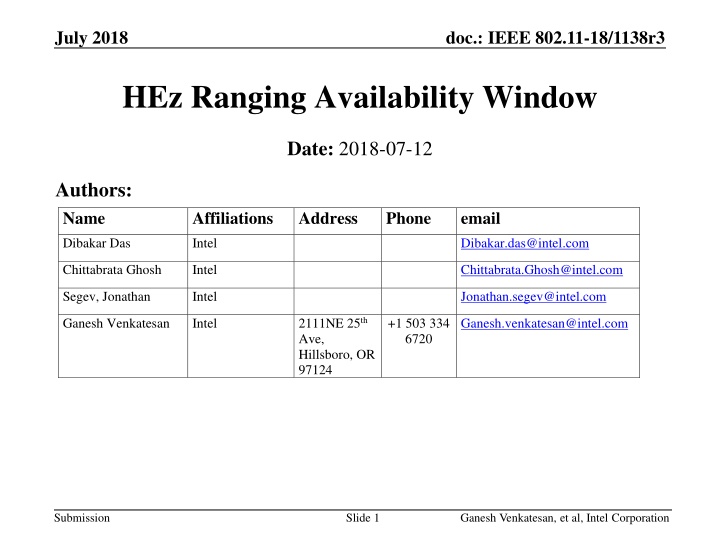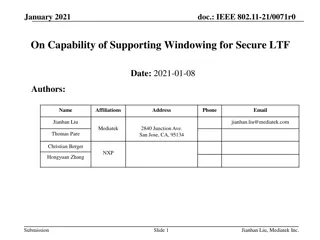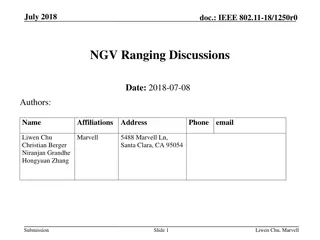
IEEE 802.11-18/1138r3 HEz Ranging Availability Window Structure
"Explore the proposal for representing and assigning Ranging Availability Windows in HEz Ranging for IEEE 802.11-18/1138r3. Learn about the structure, mechanisms, and communication methods involved in this presentation by Ganesh Venkatesan and team from Intel Corporation."
Download Presentation

Please find below an Image/Link to download the presentation.
The content on the website is provided AS IS for your information and personal use only. It may not be sold, licensed, or shared on other websites without obtaining consent from the author. If you encounter any issues during the download, it is possible that the publisher has removed the file from their server.
You are allowed to download the files provided on this website for personal or commercial use, subject to the condition that they are used lawfully. All files are the property of their respective owners.
The content on the website is provided AS IS for your information and personal use only. It may not be sold, licensed, or shared on other websites without obtaining consent from the author.
E N D
Presentation Transcript
July 2018 doc.: IEEE 802.11-18/1138r3 HEz Ranging Availability Window Date: 2018-07-12 Authors: Name Affiliations Address Phone email Dibakar Das Intel Dibakar.das@intel.com Chittabrata Ghosh Intel Chittabrata.Ghosh@intel.com Segev, Jonathan Intel Jonathan.segev@intel.com 2111NE 25th Ave, Hillsboro, OR 97124 Ganesh Venkatesan Intel +1 503 334 6720 Ganesh.venkatesan@intel.com Submission Slide 1 Ganesh Venkatesan, et al, Intel Corporation
July 2018 doc.: IEEE 802.11-18/1138r3 Motivation/Background Submission 18-855r1 discussed the notion of Availability Window for HEz Ranging In this presentation, we propose a structure to represent the Availability Window and describe the mechanism to assign a Ranging Availability Window to an ISTA in order to execute HEz Ranging Exchange. Submission Slide 2 Ganesh Venkatesan, et al, Intel Corporation
July 2018 doc.: IEEE 802.11-18/1138r3 Ranging Availability Window Assignment ISTA includes a Availability/Unavailability bit mask element in IFTMR RSTA assigns an Availability Window that best fits its operating conditions and the Availability/Unavailability bit mask of the ISTA to the ISTA and includes the assigned Availability Window in IFTM TBD how does RSTA communicate Ranging Availability Window change(s)? Submission Slide 3 Ganesh Venkatesan, et al, Intel Corporation
July 2018 doc.: IEEE 802.11-18/1138r3 HEz Specific Subelement Fields included in IFTMR frames Unavailability element describing ISTA s Unavailability (Availability) Fields included in IFTM frame when Status is Successful: Ranging ID Ranging ID assigned to the initiator (463r1) only to unassociated STA; Associated STAs use AID instead of Ranging ID. Response: Immediate or Delayed MaxToAAvailableExp BSS Color* Ranging Window (Availability Window element) Ranging Window assigned to the ISTA for executing the HEz Ranging exchange Fields included in IFTM frame when Status is not Successful: RSTA s Availability Window for Ranging IE needs discussion * Note that IFTMR/IFTM are public access frames and hence are not colored Submission Slide 4 Ganesh Venkatesan, et al, Intel Corporation
July 2018 doc.: IEEE 802.11-18/1138r3 Ranging Availability Window Element Availability Window Information Partial TSF Duration Reserved Periodicity bits 16 6 2 8 Ranging Availability Window IE Element ID (255) Length (4n+2) Extended Element ID Count Availability Window-1 Availability Window-n Octets 1 1 1 1 4 .. 4 Submission Slide 5 Ganesh Venkatesan, et al, Intel Corporation
July 2018 doc.: IEEE 802.11-18/1138r3 Availability Window Information Defined as <Partial TSF, Duration, Periodicity> Partial TSF (Same as in IEEE802.11-2016, See next slide) Duration In 100 usec units 6-bit field describing how long the Availability Window is Range 100 usec to 6.4 msec Periodicity # of beacon intervals Size is 1 octet E.g. 3 indicates the window occurs once in three beacons Range 1 to 255 Beacons (100ms 25.5s) Submission Ganesh Venkatesan, et al, Intel Corporation Slide 6
July 2018 doc.: IEEE 802.11-18/1138r3 Partial TSF Truncated TSF value As defined in IEEE802.11-2016 (Cl. 9.4.2.166 Fine Timing Measurement Parameters element) 2 octets wide (bits 25:10 of TSF) The Partial TSF Timer value is derived as follows, so as to have units of TUs: from the 64 TSF timer bits at the start of the first burst instance of an FTM session, where the 10 least significant bits equal 0, remove the most significant 38 bits and the least significant 10 bits. Reference for the Partial TSF Partial TSF along with Periodicity is an offset to the TSF in the most recent Beacon (after accounting for Periodicity) transmitted by the RSTA If included in a Probe Response, the Partial TSF along with Periodicity is an offset to the TSF (after accounting for Periodicity) in the Probe Response Note that the Partial TSF value is adjusted appropriately to match the elapsed time in Tus between the last transmitted Beacon and the TSF in the Probe Response Submission Slide 7 Ganesh Venkatesan, et al, Intel Corporation
July 2018 doc.: IEEE 802.11-18/1138r3 Ranging Unavailability Element Element ID (255) Length Extended Element ID Count Reserved Unavailability Unavailability Bits 8 8 8 9 7 1 .. 1 Example: Count: number of bits in the Unavailability field (bit pattern) 12` Unavailability field (bit pattern) 1110000000111 0 10 ms 10 20 ms 20 30 ms 30 40 ms 40 50 ms 50 60ms 60 70 ms : Unavailable : Unavailable : Unavailable : Available : Available : Available : Available 70 80 ms 80 90 ms 90 100 ms 100 110 ms 110 120 ms 120 130 ms 130 140 ms : Available : Available : Available : Available : Unavailable : Unavailable : Unavailable Submission Slide 8 Ganesh Venkatesan, et al, Intel Corporation
July 2018 doc.: IEEE 802.11-18/1138r3 Ranging Unavailability Element Implies periodicity requested by ISTA e.g., 1110000000111 => periodicity of 140 TUs. Expects to be polled once per period ISTA has the option to respond/not respond Length: ceil(Count/8) + 2 Granularity is fixed at 10 TUs Count (number of bits in the Unavailability bits): Availability: 1 Unavailable, 0 Available Reference to the Unavailability field TSF Synchronized to the start of the next Beacon of the corresponding RSTA Submission Slide 9 Ganesh Venkatesan, et al, Intel Corporation
July 2018 doc.: IEEE 802.11-18/1138r3 Straw Poll We support the proposed Ranging Availability Window assignment procedure described in this submission ISTA describes its Unavailability/Availability using a bit pattern (in IFTMR) that is synchronized to the RSTA s TSF (based on the last received Beacon from the RSTA or other means) RSTA assigns a matching Ranging Availability Window and returns it in IFTM ISTA becomes available and listens to the RSTA s Trigger (Location Poll) at the start of the Ranging Availability Window in order to execute the HEz Ranging protocol with the RSTA Y: 13, N: 0, Abstain:0 Submission Slide 10 Ganesh Venkatesan, et al, Intel Corporation
July 2018 doc.: IEEE 802.11-18/1138r3 Motion Move to approve the following exchange for a RSTA to assign a Ranging Availability Window to an ISTA: ISTA describes its Unavailability/Availability using a bit pattern (in IFTMR) that is synchronized to the RSTA s TSF (based on the last received Beacon from the RSTA or other means) RSTA assigns a matching Ranging Availability Window and returns it in the corresponding IFTM ISTA becomes available and listens to the RSTA s Trigger (Location Poll) at the start of the Ranging Availability Window in order to execute the HEz Ranging protocol with the RSTA Mover: Ganesh Venkatesan Seconder: Qinghua Li Result:11/0/1 Submission Slide 11 Ganesh Venkatesan, et al, Intel Corporation
July 2018 doc.: IEEE 802.11-18/1138r3 Refinements Define a minimum pattern size for the Unavailability bit pattern Quantize the pattern to be of certain size E.g. multiples of 10 bits (100 msec) The pattern cannot be any arbitrary size but multiples of the Quanta. Unavailability bit pattern implies a ISTA proposed periodicity Note that the assigned Ranging Availability Window may have a shorter periodicity. In such cases the periodicity implied by the ISTA s bit pattern indicates how often the ISTA may be expected to respond to Trigger (location poll) when the Ranging Availability Window opens. Submission Slide 12 Ganesh Venkatesan, et al, Intel Corporation






















